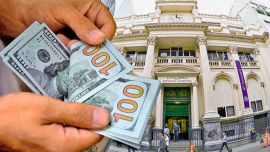Argentina has essentially no dollars. Which, as critics see it, is a major impediment to presidential front-runner Javier Milei’s plan to dollarise the crisis-ravaged economy. Even Milei’s own advisers are starting to get fidgety about how barren the vaults are.
But ask economist Francisco Zalles about this problem and he scoffs. Just go ahead and make the dollar the country’s official tender, he says, and do it fast. The faster the move, the faster inflation steadies. Then interest rates can come down, and dollars can start flowing in, paving the way for growth.
Zalles is no ordinary economist. He’s one of the few in the world who’s got experience carrying out such a process, having done so in his native Ecuador two decades ago. Conditions then — soaring inflation, plunging currency, stagnant growth — were broadly similar to those in Argentina today. And while Ecuador’s economic record has been uneven since, one thing is certain: the runaway inflation that was making people poorer month after month has disappeared.
“For Milei’s plan to work, he needs nothing,” Zalles, who’d go on to do a stint at Greylock Capital Management, said in an interview. “He just needs to dollarise.”
To many sceptics, Zalles’ vision is dangerously optimistic, even reckless. With no dollars to defend the exchange rate — Argentina has an estimated negative US$10 billion in net international reserves — ditching the peso risks sparking a collapse in the currency that could lead to hyperinflation, a possible run on the banks and social unrest as savings vanish.
“Dollarising without dollars is like saying you want the entire population to wear Nike sneakers, even though you don’t make them and you don’t have the resources to buy them,” said Alejandro Werner, a former IMF director for the Western Hemisphere. “It’s impossible.”
Zalles — and Milei — recognize dollarising is a drastic move, but argue it’s the cure for what is, after all, a dire situation.
Inflation data Wednesday will likely show prices rose by double digits on a monthly basis in August, the fastest pace since Argentina exited hyperinflation three decades ago. The economy is on the brink of its sixth recession in a decade; 40 percent of the population lives below the poverty line. The peso has tumbled almost 30 percent on the parallel market in the past month.
Since his surprise win in the August primaries, which prompted the government to devalue the peso by 18 percent, Milei’s radical plans have monopolised Wall Street’s attention. But key details, including exactly how those measures are going to play out, are still lacking. Some of his advisers have begun walking back some aspects of the proposals amid a barrage of criticism, saying he would not dollarise right away if there are no greenbacks in the Central Bank — which Milei doesn’t actually intend to shut either, they say.
Zalles shrugs off major concerns. There are gross reserves to tap, he says, and the growing use of dollars will help smooth the process. While Argentines haven’t yet resorted to paying for daily transactions in US dollars, large purchases — anything from apartments to cars, furniture, electronics and home appliances — are increasingly done in greenbacks. People are estimated to hold as much as US$200 billion in cash outside the banking system within the country and hoard an additional US$250 billion in overseas accounts.
Once you dollarise, that money will flow into the system, Zalles argues, and assuage fears over a potential bank run, similar to what happened in Ecuador in early 2000 when Zalles and two other economists oversaw the switch from sucres to greenbacks.
Stability shock
Of course, Ecuador had about US$870 million in reserves in its central bank then, according to data compiled by Bloomberg, partially due to a freeze on banking deposits in the months before, which bred widespread unrest. Dollarisation quickly passed Congress and was signed into law by March of that year. Within months the central bank had purchased almost all the sucres in circulation.
Building the political support may be the biggest challenge for Milei — a one-term, outsider lawmaker with no party support, and few allies in congress.
“You have to convince people, you have to earn it,” said Manuel Hinds, a former El Salvador finance minister and architect of that nation’s own dollarisation plan. “You’re playing with everybody’s savings so it has to be totally foolproof.”
Things will likely get much worse before they can get better. In Ecuador, the sucre lost about a quarter of its value in the week before dollarisation was announced. A fresh slump for the peso would fuel even more inflation, which is already expected to have leaped more than 10 percent in August after the currency’s most recent plunge, with similar increases forecast for September.
And while switching to greenbacks helped stabilise inflation, Ecuador’s growth has been largely in line with the region. Dollarising didn’t keep the country from defaulting on its debt or having to — like Argentina — resort to the International Monetary Fund for help amid recurring bouts of political turmoil.
“There will have to be a very strict fiscal policy and very, very good management,” Domingo Cavallo, who orchestrated Argentina’s convertibility systems in the 1990s, said on local TV station TN Sunday.
That experiment culminated in chaos, with the country going through five presidents in two weeks amid mass looting and riots, a response to the government freezing most bank accounts and cutting wages and pensions in a last-ditch bid to avoid what would become, at the time, the biggest sovereign default in history.
Estimates for how long Argentina would have to endure what would be a painful process vary. Zalles says it would happen right away — being allowed to buy and sell in dollars would become so popular that it would be hard for the government to reverse the process. Hinds suggested six months “would be fast.” Cavallo said between 12 to 18 months.
Optimistic as he is, even Zalles says ditching the peso won’t be a cure-all. For it to work, the government will need to lift capital controls and slash spending, including subsidies and state handouts that governments from the left and the right have baulked at scaling back.
“The challenge for Argentina will be whether it’s able to cut deeply into the fiscal budget,” he said. “If Milei does that, dollarisation will be a good measure that will bring the deficit under control through growth.”
by Scott Squires, Bloomberg
























Comments